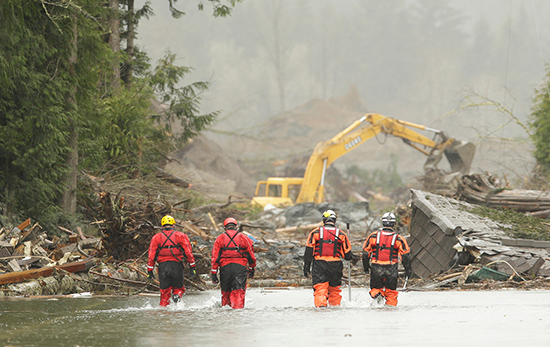|
Subscribe / Renew |
|
|
Contact Us |
|
| ► Subscribe to our Free Weekly Newsletter | |
| home | Welcome, sign in or click here to subscribe. | login |
Construction
| |
 |
January 26, 2015
Transportation
National finalist: Gold award
Jacobs/GeoEngineers
Project: SR 530 emergency roadway reconstruction
Client: Washington State Department of Transportation
On March 22, 2014, a catastrophic landslide near Oso flowed thousands of feet across the Stillaguamish River Valley, obliterating dozens of homes and spreading 10 million cubic yards of mud, trees and debris over a half-mile area. The slide buried approximately one mile of state Route 530 — a critical highway that connects a string of rural communities — with up to 20 feet of debris, closing it for four months.
It was against this backdrop that Jacobs, GeoEngineers and SDA — the design firms on Atkinson Construction’s SR 530 emergency roadway reconstruction design-build team — began working with the Washington State Department of Transportation and local stakeholders to rebuild the roadway and deliver much-needed resources and hope to the area.
The team helped WSDOT:
• Reopen the roadway extremely quickly, reconstructing an approximately one-mile stretch of highway exactly six months after the landslide — one of the fastest design-build deliveries in WSDOT history.
• Open a temporary two-way corridor within days, enabling goods and people to travel between areas that had been isolated for months.
• Save $5.4 million over WSDOT’s projected cost, due in part to the design-build team’s creative habitat mitigation plan, fish-friendly designs that were less costly to install, innovative roadway designs and use of existing stormwater mitigation best management practices.
• Take a different approach to the traditional permitting process and trust that the design-build team could mitigate impacts and finalize permits after construction.
• Incorporate project elements that helped the community heal after the devastating landslide.
• Demonstrate that emergency design-build projects can be built extremely quickly, with a high degree of cooperation and without compromising project quality or the environment.
The team’s efforts to address these pressing needs and help the affected communities rebuild is engineering at its best. As a result of the SR 530 project’s remarkable success, the state now has the confidence that it can use a design-build model under emergency conditions. Perhaps more importantly, the project also demonstrated that engineering firms can effectively adapt under very difficult circumstances and lead stakeholders to effective solutions, despite overwhelming challenges. And in doing so, engineers showed they can do more than design infrastructure: They can help heal communities.
Other Stories:
- National finalist: Platinum award
Magnusson Klemencic Associates - Complexity
Best in State: Gold award
Parametrix - Social/economic sustainability
Best in State: Gold award
Hart Crowser - Future value to engineering profession
Best in State: Gold award
Herrera Environmental - Future value to engineering profession
Best in State: Gold award
David Evans and Associates - Originality/innovation
Best in State: Gold award
Tetra Tech - Structural systems
National finalist: Gold award
CKC Structural Engineers - Structural systems
National finalist: Gold award
HNTB Corp. - Structural systems
National finalist: Gold award
Buckland & Taylor - Structural systems
National finalist: Gold award
Hart Crowser - Exceeds owner/client needs
Best in State: Gold award
Hart Crowser



